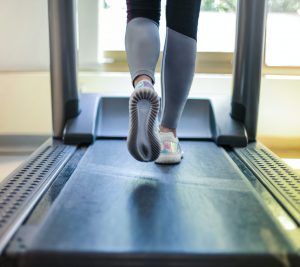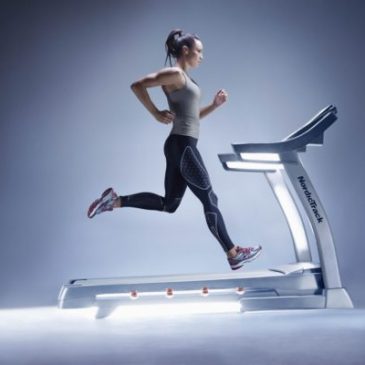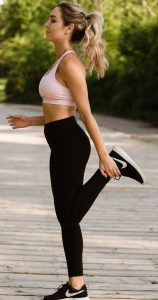 BENEFITS of a Treadmill.
BENEFITS of a Treadmill.
Walking or running on a treadmill are great ways to get fit and healthy ( and get the weight off ) while decreasing your risk of cardiovascular disease as well.
Working out on the treadmill reduces the impact on your joints and as the surface is more consistent compared to running out doors treadmills reduce the risk of injury.
Blood circulation is improved. By increasing your heart rate while exercising (ie under stress) the heart is strengthened increasing your oxygen uptake (more efficient to pump oxygen). As your heart becomes more efficient your body works more economically even at low intensity and your resting pulse rate will reduce.
Using a treadmill also improves your cardiovascular system , strengthens your abdominal muscles and generally the lower body muscles as well. Keep in mind by varying your workouts using different programs which incorporate longer sessions, faster sessions or more intense sessions with more hills or more resistance than additional strengthening of the above mentioned body systems will improve your walking and running capabilities not to mention your overall results.
Other benefits from exercising on a treadmill are the reduction in stress levels and a boost to Brain power enhancing neurotransmitters.
Make sure you wear clothing that is light and comfortable, shoes should be of good quality giving foot support, shock absorption and therefore taking additional pressure off your joints.
Considerations when purchasing a treadmill :
Most machines will feature a number of workout programs to keep your routine fresh with variety. These programs are usually goal orientated and provide fluctuating intensities and inclines. Some machines allow you to design your own programs with individual profiles for different participants.
The mid range and better spin bikes offer standard displays include distance, speed, time, a calorie counter and a heart rate monitor which helps you to monitor the intensity and the recovery of the workout. The more basic models give time and distance only. An important aspect of the display panel is that it should be convenient, clear and easy to read.
 Consider the Space at home that`s available for your new treadmill. The better the unit the bigger and bulkier they tend to be so decide if it will stay in one place or be stored away. The treadmill needs to be stable and sturdy as with the quality of the mid to high range units so be careful if you favour the cheaper models making sure they are stable and there is no additional vibration.
Consider the Space at home that`s available for your new treadmill. The better the unit the bigger and bulkier they tend to be so decide if it will stay in one place or be stored away. The treadmill needs to be stable and sturdy as with the quality of the mid to high range units so be careful if you favour the cheaper models making sure they are stable and there is no additional vibration.
The Belt Size should be appropriate for the tallest users as they have the longest stride.
Cushion Deck is important as it absorbs the weight and impact from the runner protecting the joints and ligaments and so reducing the risk of damage. There is usually a maximum weight for the machine as well.
Foot Panels at each side of the belt should be wide enough for standing on before and after workouts.
Belt Speed should not reduce when hoping on to the unit indicating the motor has sufficient torque. The treadmill should have a good maximum speed for jogging or running and should be around 16 km/hour and for walkers 10km/hour is desirable allowing for all standards. Serious runners should check the top speed is suitable.
Horse Power should be at least 2 Horse Power ( HP ). Check the Noise level under load is satisfactory otherwise an irritating sound level may end your training program prematurely.
Finally a Safety Key is an ideal addition to your treadmill. The safety key should be conveniently located for easy access and used regularly to familiarize it`s location in case of an emergency.
MUSCLES INVOLVED on the TREADMILL
The main muscles in use are the abdominal (stomach ), lower back , quadriceps ( thigh ), hamstrings (posterior compartment of the thigh ), gluteal muscle group or the buttocks (including the gluteus maximus, medius and minus), hip flexors ( the muscles around the hip area ) , calf muscles ( back portion of the lower leg ) and the heal area which is attached via the achilles tendon. A special mention of the core muscles which are the engine of the body are very involved in any activity so any additional strength training in this area will benefit your running performance.
The Core muscles include the abdominals and Latissmus Dorsi (lower back) which drive the legs and helps maintain posture.
The Quadriceps are a muscle group of four major muscles at the top of the leg. They make up the strongest of all muscles in the body and attach to the knee cap and play a major role when running.
The Hamstrings are on the top back of the leg and their function is to bend your hip and flex your knee. They sit behind the knee and attach to the femur bone (the longest bone in the body ).
 WARM UP . Getting Started
WARM UP . Getting Started
STRETCHING
A good preparation before your workout can reduce the risk of injuries so by warming up with a slow jog, calisthenics or skipping and once warm stretching before (and after) the workout is recommended.
Basic stretches ;
Hamstring stretch by touching your toes while standing and keeping your legs and back straight ( ie bend from the hips ).
Quadricep stretch (pictured) while standing on one leg bring the heal of your bent 2nd leg towards your buttocks and push that quadricep forward which will give it a good stretch. The
Calf muscle stretch, push your lower leg forward from the knee while keeping your foot flat on the ground. You can also stand on a step dropping the heal and pushing the knee forward.
Always warm up before stretching and don`t over stretch. Like all activity ease into it.
Stretching after the workout is also beneficial again reducing the risk of injury but also reducing a lactic acid build up. Lactic acid occurs when there is not enough oxygen in the muscles to break down glucose and glycogen. So cool down gradually !